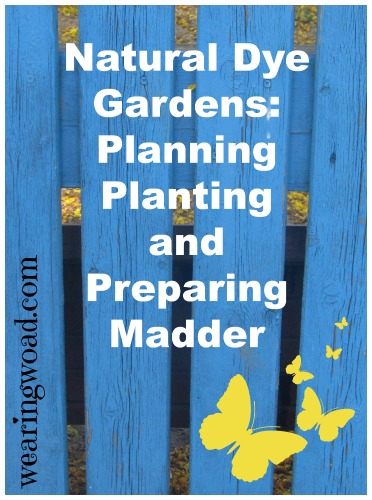Of all colors in history, Red was the most prized. Difficult to obtain, and exceptionally difficult to achieve a true red, through history this color was an exclusive of those of rank. Kings, nobles, and sometimes clergy wore this color with impunity, and in the minds of men it became a symbol of wealth and status.
Reds, in natural dyes, have always been difficult to achieve. Madder red, the only available plant based red, is sourced from the roots of the Madder, and related family, plants. The roots of the Madder plant are harvested when the plant is five years of age, and roots over the size of a pencil are the most valued.
About the Madder Plant:
The madder family have square stems, and narrow pointed leaves that feel reminiscent of Velcro. If you have encountered “Cleavers” in your garden, you have encountered a wild member of the madder family. The family includes the various bedstraw plants, all bearing the characteristic square stem, and narrow pointed Velcro-feeling leaves.
The roots, of the plants in this family, have an orange-red color when cut or broken.
One madder plant takes five years to produce roots of a sufficient size for use as a dye. While the roots can be harvested several times from one plant, standard practice is to completely clear the madder bed and then replant some roots to start a new bed. The madder plant can be divided, to form a new plant for a new bed, at any time during its five years of growth. In the right climate, madder will also produce seeds that can be planted to start a new bed.
Garden Planning:
Madder requires relatively loose and deep soil to facilitate root production. It can grow in clay soils, but prefers soils that are lighter. Starting with a relatively rich soil will enable the plant to thrive in its first few years, and help you have enough growth to divide for new beds.
If you want a continuous supply of madder, you will need to start one bed per year. After five years, you can harvest the first bed, and so on as each bed reaches its fifth year. Madder is a perennial plant, and its roots will spread in the garden. However, it is not a vigorous spreader in my experience. If you have only a small amount of garden space, planting madder in isolated beds, deep containers, or other methods may work to keep it contained and well managed.
The top of the madder plant grows in a bushy profusion of light green foliage. It is prickly, and rough, so having it away from frequently traversed paths may be a good idea. The foliage can grow over two feet tall, in the right climate, though in my experience it has never grown much beyond one foot tall.
For the healthiest madder plants, thoroughly weeding out grass and yearly mulching will greatly improve the plant’s vigour and growth. Some addition of compost or manure, before the yearly mulch, can also improve the plant’s well-being. Basically, care for madder in the same way you would care for any other perennial that needed to remain vigorous for several years.
Harvesting Madder:
Madder, whether wild or tame, should be harvested in the fall after the foliage begins to die back. This die back stores all the goodness of the plant down into the roots, which increases the dye potential of the roots.
Roots should be dug, and have the dirt washed off them. Then, the can be trimmed to manageable lengths if necessary before being dried. After madder roots are thoroughly dried, they can be stored indefinitely, provided they do not get wet (in which case they might mold).
For dyeing with madder root, the roots should be chopped up or ground and then added to the dye vat. If the roots are ground, the powder can be contained in a fine mesh or gauze bag that lets water flow easily through it. Dye matter should be removed from the vat before the addition of fiber, to save picking lots of pieces of extra veggie matter out later.
Back to You:
What is your favorite natural dye garden plant?
Leave a comment, I enjoy hearing from you!